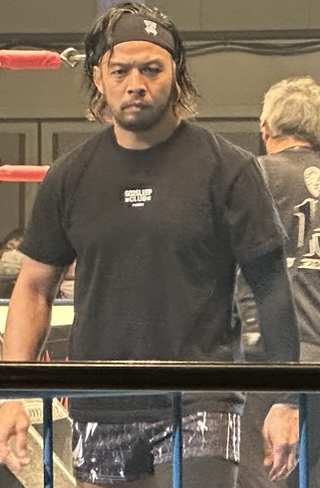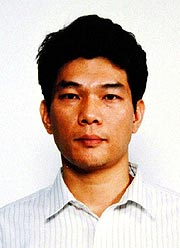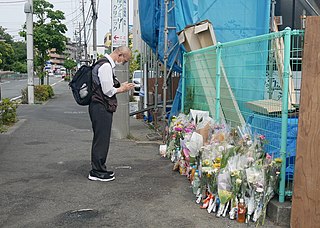
Shoko Asahara, born Chizuo Matsumoto, was the founder and leader of the Japanese doomsday cult known as Aum Shinrikyo. He was convicted of masterminding the 1995 sarin gas attack on the Tokyo subway, and was also involved in several other crimes. Asahara was sentenced to death in 2004, and his final appeal failed in 2011. In June 2012, his execution was postponed due to further arrests of Aum members. He was ultimately executed along with other senior members of Aum Shinrikyo on July 6, 2018.

Hikaru Utada, also known by the mononym Utada, is a Japanese singer, songwriter and producer. Utada is one of the most influential and best-selling musical artists in Japan.

Ikeda is a city in Osaka Prefecture, Japan. As of 31 March 2023, the city had an estimated population of 103,064 in 49723 households and a population density of 4700 persons per km². The total area of the city is 22.14 square kilometres (8.55 sq mi). It is a suburban city of Osaka City and a part of the Kyoto-Osaka-Kobe metropolitan area.

Amagasaki is an industrial city located in Hyōgo Prefecture, Japan. As of 30 November 2022, the city had an estimated population of 455,555 in 223812 households, and a population density of 9000 persons per km². The total area of the city is 50.72 km2 (19.58 sq mi).

The Tokyo subway sarin attack was an act of domestic terrorism perpetrated on 20 March 1995, in Tokyo, Japan, by members of the cult movement Aum Shinrikyo. In five coordinated attacks, the perpetrators released sarin on three lines of the Tokyo Metro during rush hour, killing 13 people, severely injuring 50, and causing temporary vision problems for nearly 1,000 others. The attack was directed against trains passing through Kasumigaseki and Nagatachō, where the National Diet is headquartered in Tokyo.

Japan Air System Co., Ltd. (JAS) was the smallest of the big three Japanese airlines. In contrast to the other two, JAL and ANA, JAS' international route network was very small, but its domestic network incorporated many smaller airports that were not served by the two larger airlines. As an independent company, it was last headquartered in the JAS M1 Building at Haneda Airport in Ōta, Tokyo. It has since merged with Japan Airlines.

Osaka University, abbreviated as Handai (阪大), is a national research university in Osaka, Japan. The university traces its roots back to Edo-era institutions Tekijuku (1838) and Kaitokudo (1724), and was officially established in 1931 as the sixth of the Imperial Universities in Japan, with two faculties: science and medicine. Following the post-war educational reform, it merged with three pre-war higher schools, reorganizing as a comprehensive university with five faculties: science, medicine, letters, law and economics, and engineering. After the merger with Osaka University of Foreign Studies in 2007, it became the largest national university in Japan by undergraduate enrollment.

Kenta Kobayashi, known mononymously as Kenta, is a Japanese professional wrestler. He currently works for New Japan Pro-Wrestling (NJPW), where he is a member of the Bullet Club stable. A former amateur kickboxer, Kobayashi's wrestling style is based upon strong kicks and strikes. Kobayashi pioneered both the Go 2 Sleep and Busaiku Knee kick finishing manoeuvres, later popularized by CM Punk and Bryan Danielson, respectively.

Mamoru Takuma was a Japanese mass murderer who killed eight children in the Osaka school massacre in Ikeda, Osaka Prefecture, on 8 June 2001.

"Final Distance" is a song by Japanese recording artist Hikaru Utada for her third studio album Deep River (2002). Written by Utada herself, the song was produced and composed by long-time collaborators Akira Miyake, Utada's father Teruzane Utada and herself. "Final Distance" was originally recorded as "Distance" which was taken from the album with the same name, despite not being a single. The song was re-recorded, re-arranged, and dedicated to Rena Yamashita, a six-year-old victim of the Osaka school massacre who had written an essay about being inspired by Utada.
Kaoru Kobayashi was a Japanese newspaper deliveryman who kidnapped, sexually assaulted and murdered 7-year-old Kaede Ariyama in Nara, Nara Prefecture, on November 17, 2004. Kobayashi, an ex-convict and pedophile with a record as a prolific sex offender, was sentenced to death for the murder of Ariyama and was executed by hanging at Osaka Detention House on February 21, 2013. Ariyama's murder caused a surge in the moral panic against otaku culture in Japan.

Masami Kobayashi was an admiral in the Imperial Japanese Navy during World War II. His name was sometimes misspelled as "Marasmi Kobayashi" or "Marashi Kobayashi" by contemporary United States Navy sources. He was an outspoken proponent of the Treaty Faction within the Imperial Japanese Navy.

The Akihabara massacre was an incident of mass murder that took place on 8 June 2008, in the Akihabara shopping quarter in Chiyoda, Tokyo, Japan. The perpetrator, 25-year-old Tomohiro Katō of Susono, Shizuoka, drove into a crowd with a rented truck, initially killing three people and injuring two; he then stabbed at least twelve people using a dagger, killing four other people and injuring eight.
Atsushi Sakahara is a film director, writer, and producer. He now teaches at Kyoto Seika University and graduate program at Osaka City University. He is a former advertising executive at Dentsu inc who survived the 1995 sarin gas attacks in Tokyo, which led to his later film work. He produced the 2001 Short Film Palme d'Or winning Bean Cake, directed by David Greenspan. He directed a short film, Don't Call Me Father. in 2012. One of producers for the film was Paul Milgrom, who won Nobel Prize in Economics in 2020. In 2015 he began to work on what would become Me and the Cult Leader, a film following his pursuit of truth and justice by talking and travelling with current Aleph executive Araki Hiroshi. He is currently pursuing a Ph.D. in engineering at Utsunomiya University's school of regional development and creativity. He is also known as an inventor of the SA method, which is a unique idea-generation technique and application. He is a member of The Japan P.E.N Club. Olivia Rosenthal, a french novelist interviewed him in 2018 and released a novel based on it in 2022. He co-founded Logiglish Inc.., a language education company, with Kaho Fujikawa, his student at Osaka Metropolitan University. He founded Sarin Gas Attack Victims Association in 2022 for his experience that he was anti-democratically not allowed to join Tokyo Subway Sarin Gas Attack Victims Association represented by a widow without any particular reasons and list Japan National Police Agency in 2023.
Events in the year 1994 in Japan. It corresponds to Heisei 6 (平成6年) in the Japanese calendar.
GirlsAward (ガールズアワード), sometimes abbreviated as GA, is a semi-annual fashion and music event held at Yoyogi National Gymnasium 1st Gymnasium in Tokyo, Japan. It is one of the biggest fashion events in Japan, with approximately 30,000 people attending each time. It is organized by GirlsAward Inc. under the slogan "Shibuya to Asia, and the World" and sponsored by Ministry of Foreign Affairs, Tokyo Metropolitan Government and Fuji Television. Usually, the Autumn/Winter(A/W) event is held in September to October, and the Spring/Summer(S/S) is held in March to May of each year.

The Kawasaki stabbings occurred on the morning of 28 May 2019 in the Tama ward of Kawasaki City, Kanagawa Prefecture, Japan, four blocks west of Noborito Station. Two people were murdered, and 18 others were injured after being stabbed at a city bus stop by 51-year-old Ryuichi Iwasaki. After carrying out the attack, Iwasaki committed suicide by stabbing himself in the neck.

A mass stabbing incident occurred 6 August 2021, on a commuter train in the Odakyu Electric Railway in Tokyo, Japan. 10 people were injured in the incident.

At around 8 p.m. JST on 31 October 2021, 24-year-old Kyota Hattori carried out a knife and arson attack on a Keiō Railway train as it was travelling to Kokuryō Station on the Keiō Line in Chōfu, a city in the western suburbs of Tokyo, Japan. He injured 17 people, one critically. Japanese authorities later identified Hattori and he was arrested at the scene.















